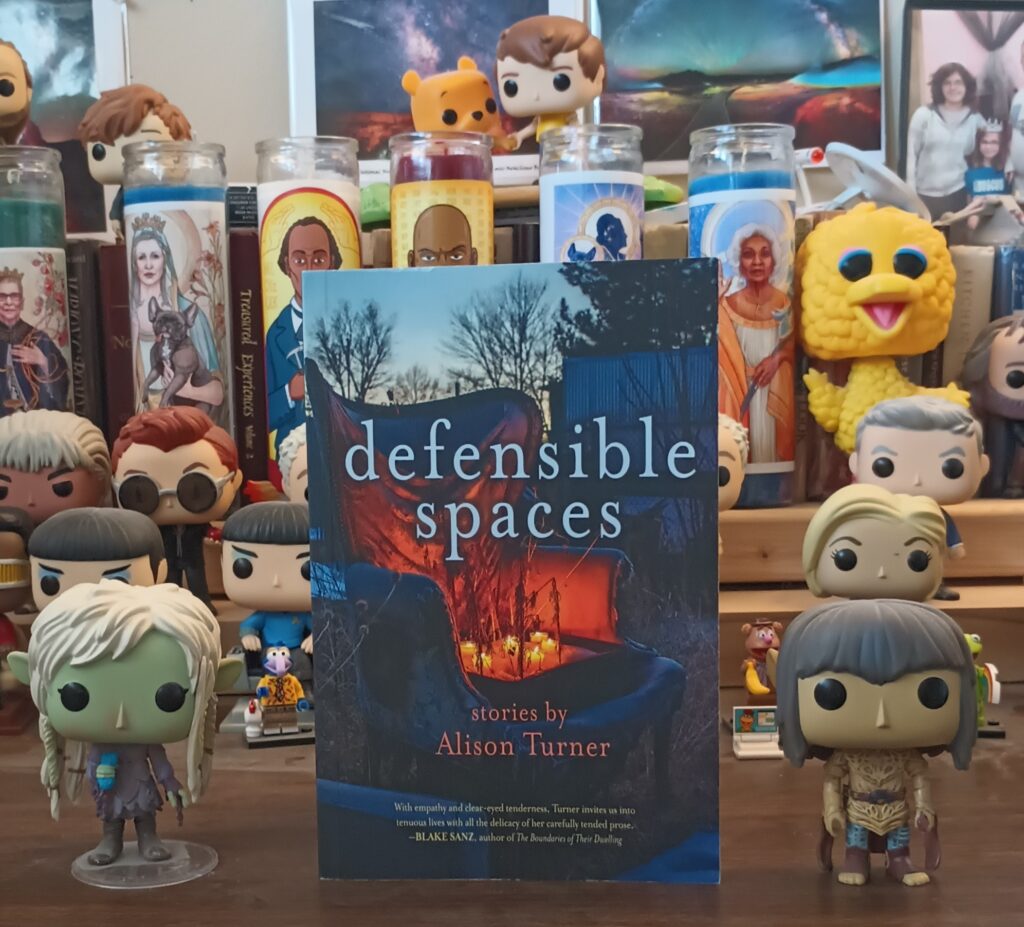Review
———
Title: defensible spaces
Author: Alison Turner
Publisher: Torrey House Press
Genre: Fiction
Format: Paperback
Date: 2023
Pages: 149
ISBN: 978-1-948814-67-6
Cost (paperback): $13.99 (on Amazon)
Reviewed by Julie J. Nichols for the Association for Mormon Letters
This collection of linked short stories demands first a slow read and then a second, quicker reread, to review and reorient you to the characters’ roles and relationships. Maybe all linked short story collections have this quality: each of the stories or chapters that comprise Visit from the Goon Squad, Love Medicine, Winesburg, Ohio—even The Decameron by some assessments—is deeply satisfying on its own, as a short story must be to work. But in concert with its neighbors, it becomes something larger than itself. The whole is meteorically more than the sum of its parts.
As with all Torrey House Press publications, in defensible spaces place is critical. Environment is key. Clayton, Colorado, is a burn zone. “Anyone living in Clayton…knows that a fire could catch any year, no matter what the accumulated rainfall,” Bonnie Hadford says in the first story (2). And catch it does. The levels and degrees, causes and consequences of the fires in defensible spaces are an explosively powerful theme.
One level is literal. A fire on July 2 (or 3), 1991, that destroys a mining museum—an archive of the town’s history–frames the collection. The consequences of that fire—allegations about its origin, efforts to photograph or restore the museum, its resonances with the industries that have arisen since the mines shut down and, most importantly, the people who make all these things happen—ripple, crackle, fan out and sear through the ten stories. Names come and go: Bonnie and Elizabeth Hadford (mother and daughter), Karly Krane (friend of Elizabeth), the Troys (white foresters) and Luceros (foresters of color)—all these, and others they love or hate or blame, stir the flames.
Perhaps it’s obvious, then, that another level is emotional and psychological. So much desire! Economic, racial, romantic—the characters race toward and scald each other, ignite each other’s hearts or soothe the burns. One by one the stories reveal the layers of linkage and likenesses among the citizens of Clayton; by the last story, the need to reread is as urgent as the need to begin was at the start. It’s a very rewarding feeling.
The title of every story has to do with fire management. All the titles are contained in the epigraph (I have highlighted them, though they’re not in this order):
The Merrill County Fire Department is always looking for volunteers to join our team! As a volunteer, you may be asked to assist in emergency extinguishing efforts as well as ongoing mitigation programs that support healthy forests and a safe Wildlife Urban Interface environment for all Merrill County residents. Among other initiatives, mitigation efforts include the Defensible Spaces Campaign, es. 2002, that supports homeowners with removing combustible debris down to the requisite fuel density for the full radius of the Home Ignition Zone, a minimum of 120 feet from all standing structures.
As of 2010, we are excited to offer a new volunteer opportunity to assist with community education and outreach. In an ongoing effort to increase resident compliance with, prescribed burns, and evacuation procedures, it is our hope that growing a network of informed and engaged volunteers will spark a fanning effect of fire prevention awareness and a decrease in arson and negligence across Merill County, Colorado.
(Merrill County Fire Department Volunteer Handbook, p. 2 updated 2014)
As you might expect, the titles of the stories are metaphors for character and narrative arcs, as Elizabeth and Karly grow up, Troys and Luceros compete, Chinese merchants and other Others are bullied, leave town and return, and opportunities blossom and die. Each story has a date attached. There is a flashback after the first and last (1991) stories, to 1987, but from there the events leap forward in time to 1994, 2002, 2006, 2011, 2013, and 2015 (twice). Like a slow burn, there’s a steady heating up, moving you forward faster and more dangerously than you realize, until that last astonished gasp.
As a kind of p.s., there’s a wonderful description of the cover art and its maker, Katie Crow, who “[pushes] tensions between nature and design and between…the simultaneous invitations of comfort and destruction [that happen when indoor furniture is sent outdoors…]” (149). It’s a perfect cover for this fine collection.
If you love fiction, if you love the West with all its flaws, if you love mountains and their people, this book will rock you. Once again, Torrey House has brought us quality of content, style, and production. Read defensible spaces fast, then read it slow, and be consumed.

